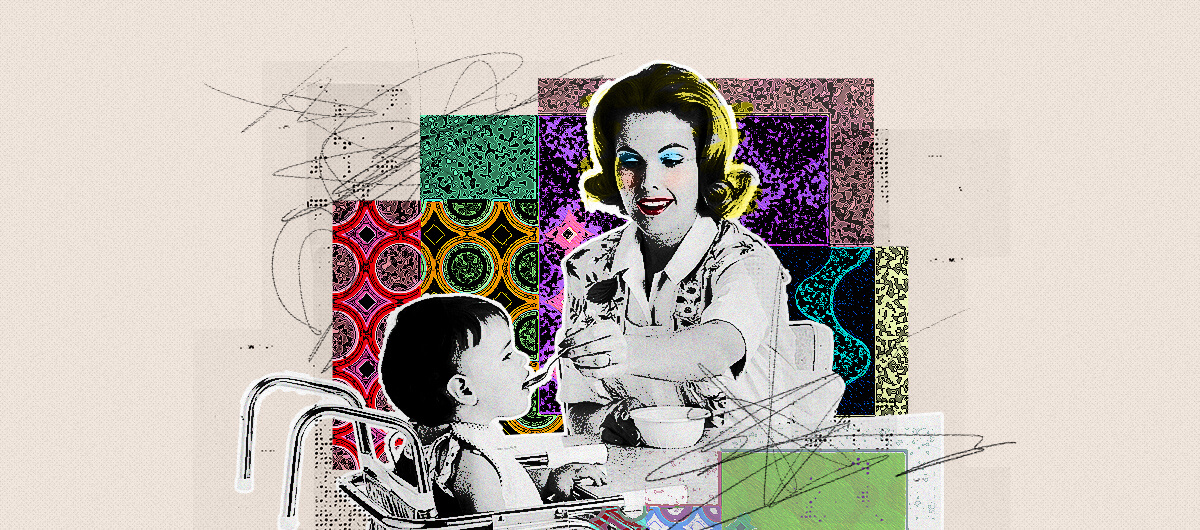

Getty/Unsplash+
Women's Work
Getty/Unsplash+
“Tradwives” Is Just Influencer Speak for Patriarchal Subordination
At a time when women in the U.S. are losing rights to their autonomy, a regressive domestic lifestyle with a long history in white supremacy is being pushed on social media by other women — and some find it quite appealing.
This article was made possible because of the generous support of DAME members. We urgently need your help to keep publishing. Will you contribute just $5 a month to support our journalism?
A blonde woman in a low-cut flowery dress and immaculately shaped eyelashes speaks softly to the camera while gentle music plays in the background. “I’m here to make a clarification video because of the controversy going around about the term ‘tradwives,’” says Estee Williams, laughing demurely. No one, she assures her listeners, is pushing the tradwife lifestyle. It is a choice. And what is that choice? Tradwives, she explains, “believe that they should submit to their husbands and serve their husbands and family.”
At a time when women in the U.S. are losing the rights to their autonomy, from abortion access to job protections, with even more rights being threatened every day, it’s curious that a regressive “lifestyle” that reestablishes patriarchal domestic structures would be so appealing. But, as the media has breathlessly reported for years now, there is an entire online ecosystem of female influencers who are celebrating the joys of turning the clock back.
Tradwives are women who advocate for traditional gender norms as an ideology and a lifestyle; their videos often show them cooking meals, raising children, wearing flowy retro dresses and talking about the joys of obedience to husbands. They embrace domesticity, homemaking, child-rearing, and, most controversially, as Williams makes clear submission to men. Her video, released in 2022, racked up more than 1.6 million views over the next two years. Tradwife content is popular, in part, because it tends to feature attractive women in feminine outfits. But many people also find the tradwife ideology and lifestyle congenial or intriguing.
Tradwife popularity has raised a lot of questions for analysts and commenters. As historian Jacqueline Beatty explained in Time magazine, tradwife content echoes hundreds of years of conservative propaganda arguing for women’s subjugation. Beatty wrote that tradwife rhetoric echoes the legal theory of coverture whereby women’s “individual, legal identities were subsumed under those of their husbands.”
Married women could not own property. Even their bodies were their husband’s property, which meant men could rape their wives with impunity.
Tradwife “advocacy for the ideology and principles of so-called ‘traditional’ gender roles in marriage,” Beatty concludes, has “the effect of promoting … an erasure of the hard-fought (if incomplete) gains of women’s rights activists throughout American history.” From this perspective, tradwives are victims, and promoters, of false consciousness; they are arguing for their own sweeping disempowerment and oppression.
It’s true that traditional hierarchies disempowered women. However, traditional hierarchies also gave certain women — white women — a kind of power. Specifically, the idealized conservative past for which tradwives advocate was white supremacy. In that context, tradwives can be seen not (just) as advocating for women’s subjugation, but as calling for a return to white power, in which they share.
White (Women’s) Power
Accounts of white supremacy have often focused on the violence and power of white men specifically. However, recent scholarship has started to investigate and reveal some of the real advantages, and some of the real wealth, which white women accrued under past white patriarchal systems.
One powerful example is Stephanie Jones-Rogers’s quietly harrowing 2019 monograph They Were Her Property: White Women As Slave Owners in the American South. Contrary to many scholars who claimed that coverture prevented married women from owning slaves in their own name, Jones-Rogers examination of the archive revealed that many white women were in fact slave-owners, and even slave traders. Custom, family, and courts all upheld white women’s right to own, sell, and beat enslaved people.
White women, Jones-Rodgers writes, could accrue substantial wealth through slave owning and slave trading. They also participated in the entitlement of white supremacy. That meant that they could casually command and demean Black people. Jones-Rodgers describes one incident in the South in which a 12-year-old girl demanded to know where an adult Black man was going and threatened to have him whipped if he did not respond.
As this suggests, white women had the power to beat enslaved people or order them beaten, sometimes to death. They could also force enslaved people to have sex to produce more children to enrich white people—in other words, white women could, and did, rape Black men and women. The patriarchal system of the antebellum South meant that white women were in many ways subordinate to and in the power of men. But it also meant that white women had financial, physical, and even sexual power because of, and over, Black people.
The potential benefits of whiteness for white women didn’t end with abolition. Frances Willard, a suffragist and temperance advocate, advanced her campaign against alcohol by leveraging racist stereotypes and white racial panic. In one infamous interview in 1890, she claimed that the main threat to temperance and the banning of alcohol in the South was voting rights for Black people. She compared the growth of Black voters to “the locusts of Egypt” and claimed Black men spent all their time at “the grog shop.” Because of Black people in the South, she said, “The safety of woman, of childhood, of the home, is menaced in a thousand localities at the moment, so that men dare not go beyond the sight of their own roof-tree.”
It’s not an accident that Willard’s vicious racism is intertwined with images of a threatened white patriarchal idyll. Willard wanted women to have the vote — but as a white woman she also saw her power as linked to whiteness. “The Anglo-Saxon race will never submit to be dominated by the Negro so long as his altitude reaches no higher than the personal liberty of the salon,” she declaimed. Virtue and power, for Willard, as a white woman, meant not (just) women’s rights, but white dominance.
Willard was broadly speaking an advocate for (white) women’s rights as well as for white supremacy. Phyllis Schafly is a more direct foremother of the tradwives lifestyle in that she believed advocating for white women meant advocating for patriarchal subjugation — even though Schlafly herself was an extremely ambitious right-wing lawyer and political activist from Missouri. She first emerged in the political realm as a staunch supporter of the 1964 presidential campaign of the far right, openly segregationist Republican Barry Goldwater.
Schlafly worked hard to secure a leadership role in the conservative movement, but the party’s sexism obstructed her ability to gain a foothold. Determined to find her voice in the party, she created her own platform in 1972: fighting against the Equal Rights Amendment. The ERA had broad bipartisan support at the time, and advocates believed it would pass easily. But Schlafly tapped into the same powerful misogyny that had derailed her own ambitions to create a successful propaganda campaign directed at married women.
Though Schlafly posed as a humble traditional housewife, extolling the virtues of domesticity and subjugation, she was working full-time lobbying against the ERA, serving as the breadwinner of her household, and had domestic help to raise her children. She claimed that the ERA would force women out of the house and into the workforce — even though poorer women, including, disproportionately, Black women, already had to work, and would have benefited from the ERA’s constitutional protections for equal employment and pay. She also claimed that the ERA would keep women from getting alimony and make it impossible to get custody of their children in divorce cases, and threaten their Social Security benefits. And that the ERA “means abortion funding, means homosexual privileges, means whatever else.”
Attacking women’s rights and blocking the ERA for Schlafly was a way to attack the rights of other marginalized and disenfranchised people — Black people, poor people, LGBT people — while advancing her own career. By joining right-wing men in denigrating women, and especially non-white, non-affluent, non-heterosexual women, she elevated herself.
What Tradwives Gain
In her 2020 book, Sisters in Hate: American Women on the Front Lines of White Nationalism, Seyward Darby writes, “Most tradwives are white, and they embrace a dream of comfort, contentment, and affluence specific to lived white experiences.” She notes that “not every tradwife is a white supremacist,” but that there is a great deal of overlap between the nostalgic white patriarchy embraced by both tradwives and far-right communities.
Darby looks particularly at an influencer named Ayla, who, from around 2015 to 2020, released content which mixed craft projects, organic recipes, paeans to European dance and cooking from a “white cultural perspective” and warnings of the dangers of immigration. “You love your wife as though she were your own body. You would do anything to keep her safe,” Ayla said in one video that would have warmed the dry shell that is Stephen Miller’s heart. “But are you really keeping her safe if you allow hordes of violent third-world immigrants into your nation?”
Ayla was able to monetize her organic recipes and her vile racism both through social media, in part by presenting herself as a victim of cancel culture and interacting with other content creators on the right. Many writers such as Katie Gatti Tassin have pointed out that the entrepreneurship of tradwives seems contradictory; tradwives, after all, claim to be submissive and financially dependent. But, Tassin notes, “These women aren’t actually financially submissive at all. In fact, many of them are making bank.” Their channels are elaborate performances of submission and humility which allow them to build independence and a personal public brand.
The contradiction resolves fairly easily, though, if you understand that tradwives are submitting to traditional patriarchal norms in order to reap the entitlements of whiteness. Slaveholding women in the antebellum South acquiesced to a very hierarchical, patriarchal society and in exchange received sweeping power over Black people. Phyllis Schafley embraced patriarchal Christofascism, and in return became an influential national political figure.
Similarly, tradwives are able to capitalize (literally) on the fact that a lot of white people are attracted to nostalgic evocations of a time of white supremacy. In a white supremacist society like ours, embracing whiteness — explicitly like Ayla or implicitly as many tradwives do — can create community, build fame and influence, and generate income. People see whiteness as pure, inspiring, sexy, righteous. This was true in the past, and it’s still, unfortunately, true today.
Preaching submission to traditional hierarchy is only disempowering if you see yourself as occupying the bottom of that hierarchy — and white people, including women, have historical and ongoing reasons to think that they are not on the bottom. Tradwives say they want to return to a time when women were dominated. The corollary, which only some like Ayla make explicit, is that they want to return to a time when white women had more latitude to dominate others.
Before you go, we hope you’ll consider supporting DAME’s journalism.
Today, just tiny number of corporations and billionaire owners are in control the news we watch and read. That influence shapes our culture and our understanding of the world. But at DAME, we serve as a counterbalance by doing things differently. We’re reader funded, which means our only agenda is to serve our readers. No both sides, no false equivalencies, no billionaire interests. Just our mission to publish the information and reporting that help you navigate the most complex issues we face.
But to keep publishing, stay independent and paywall free for all, we urgently need more support. During our Spring Membership drive, we hope you’ll join the community helping to build a more equitable media landscape with a monthly membership of just $5.00 per month or one-time gift in any amount.




















































































